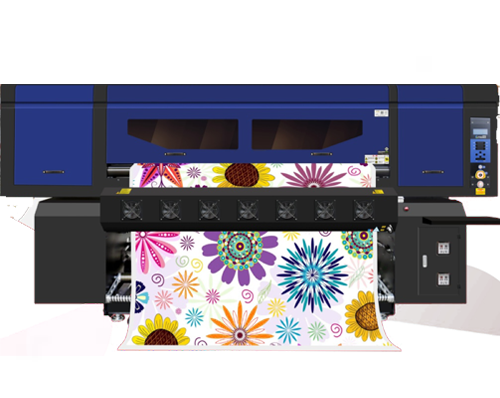Detailed maintenance ensures the stable performance of digital printing machines
Release time:
2025-07-28
As a high-precision device, digital printing machines require extra caution during daily operation, and post-operation maintenance is a core link to ensure their long-term stable operation. Through regular cleaning, detailed inspection and systematic maintenance, not only can potential problems be detected and solved in a timely manner, but also the service life of the equipment can be effectively extended, production efficiency improved, and the stability of printing quality always guaranteed. Therefore, it is recommended that users strictly follow the maintenance norms to provide a solid guarantee for the long-term efficient operation of the equipment.

| Environmental requirements |
| 1. Dust prevention measures should be taken indoors to avoid placing the equipment in environments prone to smoke and dust. At the same time, the floor should be kept clean and free of dirt. 2. Try to provide the equipment with a stable temperature and humidity environment. Generally, the suitable temperature range is 18℃ - 30℃, and the humidity range is 35% - 65%. 3. No items, especially liquids, are allowed to be placed on the surface of the equipment to prevent damage to it. 4. The equipment should be placed stably to ensure its stability during loading. Also, ensure the surface is flat during loading to avoid deviation when printing long images. 5. Common household appliances should not be placed near the equipment, and it should be kept away from strong magnetic fields and strong electric fields to avoid interference with the equipment's operation. |
| Maintenance method |
| Grating: Regularly inspect the surface of the grating to ensure there are no dust, stains, or other debris. If the cleanliness or installation position of the grating changes, it may interfere with the normal movement of the ink carriage, thereby affecting the printing quality. Special attention should be paid to this. Filter: Regularly check if the filter is clogged. If so, it should be cleaned immediately; if the clogging is severe or the cleaning effect is poor, it should be replaced in time to ensure the normal operation of the equipment. Ink stack cap: The ink stack cap, as a key component in direct contact with the nozzle, must always be kept clean to avoid affecting the performance of the nozzle and the printing quality due to residual stains. Scrapers: The ink stack cleaning unit must always be kept clean, and the scrapers must be clean and undamaged. If the scrapers are stained or damaged, it will directly affect the scraping effect and cause adverse effects on the nozzle. Ink cartridge and ink bucket: Ink cartridges and waste ink buckets need to be cleaned regularly. Due to long-term use, their bottoms are prone to residual ink and may form lumps, causing poor ink flow. Therefore, regular cleaning can effectively avoid such problems and ensure smooth ink supply. Stabilizer: It is recommended to equip each device with a stabilizer (only for printers, not for drying equipment), and the power of the stabilizer should not be lower than 3000W to ensure stable power supply for the printer and avoid equipment failure due to voltage fluctuations. Ink: Always pay attention to the ink level in the ink cartridge to ensure sufficient ink and prevent the nozzle from being damaged or clogged due to "emptying", thereby extending the lifespan of the nozzle. The printing platform: The printing platform must remain free of foreign objects to prevent the nozzle from being damaged by foreign objects during printing, affecting the normal operation of the equipment and the quality of the printed products. Print head: Regularly inspect the mirror surface and surrounding area of the print head to check if there is any debris accumulation. If so, it should be cleaned promptly. When cleaning, move the carriage to the designated cleaning position, and use a cotton swab dipped in cleaning solution to gently wipe the residual ink around the print head to avoid affecting the subsequent cleaning effect. Ink reservoir: After long-term operation of the equipment, check if the ink reservoir is loose. If so, it should be tightened promptly to prevent ink leakage or unstable ink supply due to loose ink reservoir. Transmission parts: Regularly apply lubricating grease to the transmission parts, including the gear meshing areas (such as the air tensioning shaft gears), guide rail sliders, ink stack lifting mechanisms, etc. Additionally, it is recommended to add lubricating grease to the long belt of the lateral carriage motor, which can effectively reduce running noise and improve the stability of the equipment operation. Circuit inspection: Regularly inspect the power supply lines and sockets of the equipment to check for aging or damage. If any problems are found, they should be replaced immediately to avoid potential leakage, short circuits, etc. Safety hazards. Drier: Regularly check if the power lines of the dryer are aging and if the internal lamp tubes are intact. If the power is aging or the lamp tubes are damaged, they should be promptly handled and replaced to ensure the normal operation of the drying function and avoid safety risks. Air pump: Regularly check if the air pressure of the air pump is within the normal range. If the air pressure is abnormal, it should be investigated and adjusted promptly to ensure the normal operation of related functions (such as material feeding and discharging) of the equipment. |
Keyword:
RECENT POSTS


